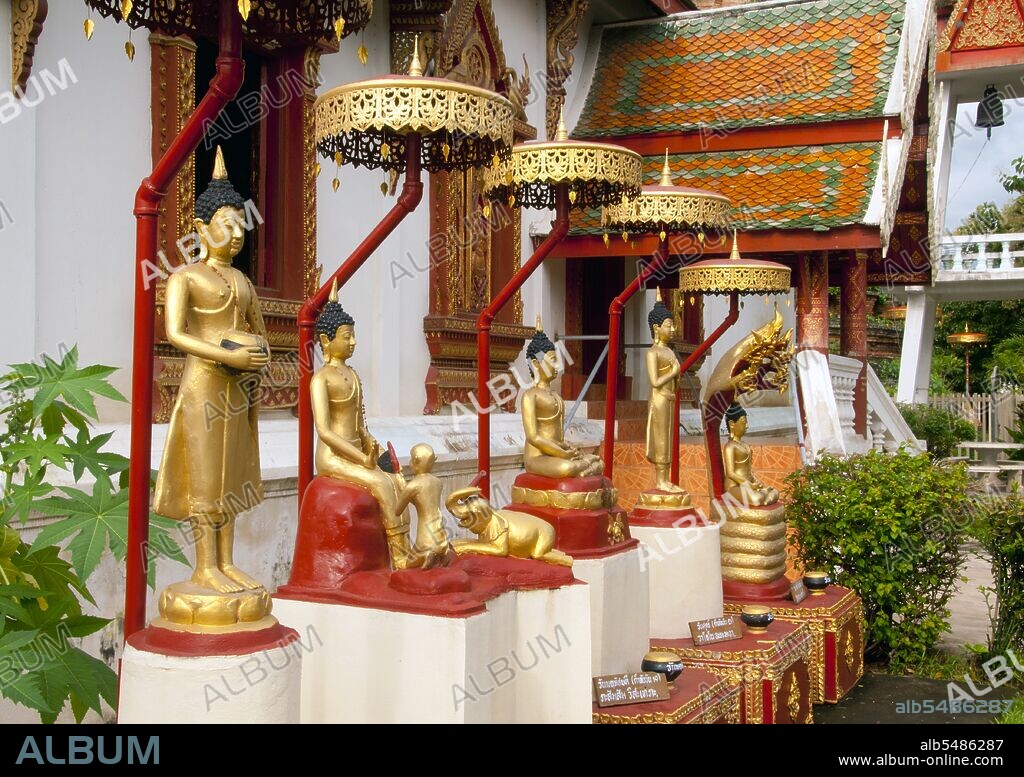alb5486287
Thailand: Buddhas by the days of the week outside the viharn at Wat Phuak Hong, Chiang Mai

|
Add to another lightbox |
|
Add to another lightbox |



Buy this image.
Select the use:

Title:
Thailand: Buddhas by the days of the week outside the viharn at Wat Phuak Hong, Chiang Mai
Caption:
Wat Phuak Hong (??????????), the 'Temple of the Flight of Swans', is located in the southwest corner of Chiang Mai Old City. A typical small Lan Na temple, it is chiefly notable for the round stupa that stands to the west of the viharn. Built in the 16th century, the rounded structure has seven diminishing tiers encircled by a total of 52 niches for images of the Buddha,some of which survive today, though in a rather damaged condition. This unusual structure, one of only four round, stepped stupas in northern Thailand, is sometimes described as a pagoda, while some experts suggest it shows signs of influence from neighbouring Yunnan Province in China. An alternative explanation is that it is a round version of the square stepped stupas dating from the 12th century found in nearby Lamphun. King Mengrai founded the city of Chiang Mai (meaning 'new city') in 1296, and it succeeded Chiang Rai as capital of the Lanna kingdom. Chiang Mai sometimes written as 'Chiengmai' or 'Chiangmai', is the largest and most culturally significant city in northern Thailand.
Credit:
Album / Pictures From History/Universal Images Group
Releases:
Image size:
4810 x 3401 px | 46.8 MB
Print size:
40.7 x 28.8 cm | 16.0 x 11.3 in (300 dpi)
Keywords:
ARCHITECTURAL • ARCHITECTURE • ARCHITECTURE. • ASIA IMAGES • ASIA PICTURES • ASIA • ASIAN IMAGE • ASIAN IMAGES • ASIAN PICTURES • ASIAN • BUDDHA • BUDDHISM • BUDDHISM, BHUTANESE • BUDDHIST • CHEDI • CHIANG MAI • CULT, BUDDHIST • DAVID HENLEY • HISTORIA UNIVERSAL • HISTORIA • HISTORICAL IMAGES • HISTORICAL PICTURES • HISTORICAL • HISTORY IMAGES • HISTORY PICTURES • HISTORY • HISTORY. • KINGDOM • LAN NA KINGDOM • LAN NA • LANNA • RELIGION • SIAM • SIAMESE • STUPA • TEMPERA • TEMPLE • TEMPLES • THAI • THAILAND • THERAVADA • VIHARA • VIHARN
 Pinterest
Pinterest Twitter
Twitter Facebook
Facebook Copy link
Copy link Email
Email
